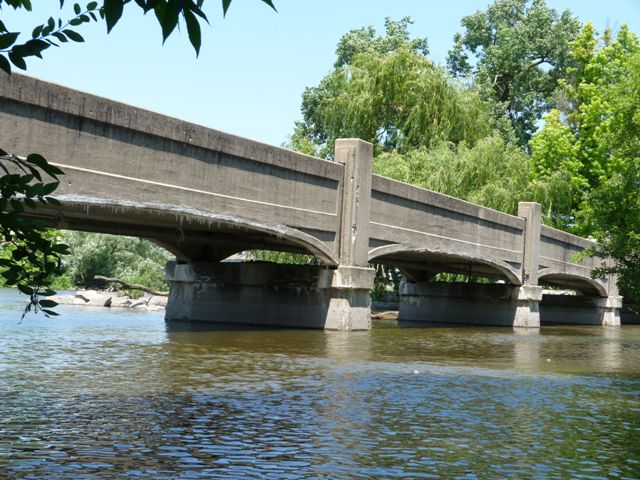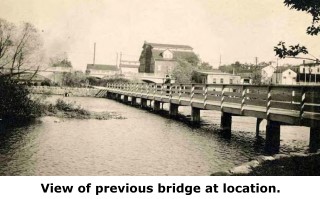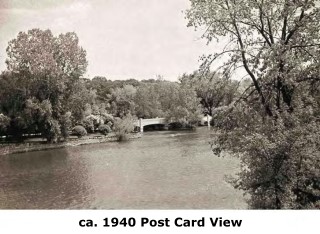We Recommend:
Bach Steel - Experts at historic truss bridge restoration.
BridgeHunter.com Phase 1 is released to the public! - Visit Now
North Island Park Bridge

Primary Photographer(s): Nathan Holth
Bridge Documented: June 26, 2011
Fox River Trail (Non-Motorized Traffic) Over Fox River East Channel
Geneva: Kane County, Illinois: United States
1931 By Builder/Contractor: Wilson Brothers of Geneva, Illinois
Not Available or Not Applicable
38.0 Feet (11.6 Meters)
182.5 Feet (55.6 Meters)
8.2 Feet (2.5 Meters)
5 Main Span(s)
Not Applicable

View Information About HSR Ratings
Bridge Documentation
This bridge no longer exists!
This rare and beautiful historic bridge was demolished June 2012 by Geneva Park District!
View Historic Preservation Commission Minutes Regarding This Bridge
View Project Information Packet From Historic Preservation Commission
View Bridge Alternatives Analysis, Inspection, and Report
A Rare Concrete Girder Bridge
This bridge is an extremely rare example of a multi-span concrete through girder, and an equally rare example of this structure type being used for a non-motorized crossing in a park setting. Perhaps the most unique aspect of the bridge however is the beauty of this bridge, a result of the unusually creative architectural detailing and design of the bridge. With the exception of curved chord through girders, concrete girders are a notoriously plain and unattractive type of historic bridge. Built mostly in the 1910s and 1920s, concrete girder bridges were used for short spans (usually under 60 feet) and they are quite a contrast to the graceful concrete arch bridges often built for larger spans in this same era. This North Island Park Bridge however is strikingly beautiful, with a subtly curved bottom chord, insect rectangular panels in the girders, and decorative pillars at each pier which have subtle hints of art deco to them. The bridge is a contributing structure to a local historic district for Geneva. As a five span structure, the bridge is unusually long for its type. Most concrete through girders are single span, and most multi-span examples are either two or three spans.
In addition to its technological and aesthetic significance, the bridge is historically significance for its association with its builder, Geneva-based Wilson Brothers. This respected firm built a number of area structures and studied under Frank Lloyd Wright.
This bridge was not the first at the location, the image to the right shows a previous wooden bridge. Also note in the distance of that photo is a concrete arch bridge, a former State Street Bridge, which no longer exists and is replaced by a modern bridge.
The Replacement Bridge: Wrong For Geneva, Wrong For America
The Geneva Park District has chosen to demolish and replace this historic bridge with a replacement bridge. The replacement bridge will apparently retain a limited amount of the original substructure and will try to replicate some of the pier architectural details, however the entire superstructure will be demolished and replaced with a modern structure of completely different type. The replacement does not preserve an existing historic bridge, nor does it replicate an existing historic bridge to provide an interpretation of a lost historic bridge. Instead, the replacement bridge superstructure combines historic and modern details, by trying to retain the details of the historic bridge under the deck (the triangle-shaped details next to the piers), while swapping out the concrete girders for metal railings above the deck, thus creating a conflicting and false sense of history in the new superstructure. HistoricBridges.org is deeply disappointed with this decision, particularly because it appears the decision to demolish and replace the bridge with a modern bridge was arrived at because too few project alternatives were considered, including any deep and thoughtful consideration of preservation or replication alternatives.
Lack of Preservation Feasibility Study
The report on the condition of the bridge and alternatives considered for the project (link available at top of this narrative) only considered two options, one to build a load-bearing bridge under the existing historic bridge, and the other to demolish and replace the historic bridge. The report failed to analyze key preservation alternatives to demolition including removal and replacement of the deck (the most deteriorated part of the bridge) while reusing the existing concrete girders. The inspection report comments that the reinforcing rods in the deck are in a "relatively corrosion free state." Despite this statement, the report fails to identify why the concrete could not be removed and replaced with new concrete, reusing the reinforcing rods. The report also failed to consider the possibility of demolishing the existing bridge and replacing it with an exact replica. The report also claims that rehabilitation is not feasible because the concrete is not air entrained. Because nearly all old concrete bridges are not air entrained, and because many concrete bridges have been preserved, this is an unacceptable comment and should not have been used in decision making. If a concrete bridge is to be found infeasible to restore, supporting evidence needs to point to deterioration in the bridge. Although air entrained concrete may be better, many bridges without this can be stable and functional.
True Replica: Interpretation. Partial Replica: False Sense of History.
Because of some of the problems with concrete, sometimes bridges can deteriorate beyond the point of feasible repair. Specifically, a type of deterioration called alkali-silica reaction in concrete can be very hard to repair. Should a bridge like the Island Park Bridge display such irreparable deterioration, HistoricBridges.org would be happy to support a project that would produce an exact replica of the bridge. This replica could use a modern formula of concrete that is more durable, and may adjust the interior reinforcing which is not visible since it is inside the concrete. However the bridge should maintain original dimensions, architectural details, and optimally should attempt to replicate the appearance of the original concrete and its aggregate, at least on the exterior surfaces. If the bridge were in fair condition and was feasible to restore, and due consideration was given to the historic value of the bridge and the importance of restoring the bridge, than engineers would be constrained to design a restoration project that maintained the existing bridge's design, dimensions, and wherever possible original materials, thus following the Secretary of Interior's Standards for Rehabilitation. Deferred maintenance should not be grounds to reward owner agencies with a free pass to demolish and replace a historic bridge with something modern. If original materials have deteriorated beyond repair, a replica should be designed. This is different than making a modern bridge structure have some of the details or some of the appearance of the historic bridge... doing that would create a fake structure that conveys a false sense of history and design. Only a true replica would give due respect and interpretive value to the historic bridge. Any replica constructed should be accompanied by interpretive signage that explains that the materials seen are modern and that they replicate a historic bridge, to avoid a misinterpretation of the replica bridge as the original bridge.
It is greatly unfortunate that the Geneva Park District chose to not seriously consider a full spectrum of preservation alternatives for this project and instead jumped so quickly to one which will deprive a beautiful park of a iconic historic bridge and leave the city with a cheesy knock-off of a historic bridge. While perhaps not as detrimental as replacing the bridge with a typical ugly Con-Tech Continental truss bridge, the project as chosen by the district is deeply disappointing indeed. Computer renderings of the replacement bridge are shown below. These renderings as well as all the historical photos shown were taken from the publically released reports on the bridge replacement project, of which copies are also provided at the top of this narrative.
![]()
Photo Galleries and Videos: North Island Park Bridge
Bridge Photo-Documentation
Original / Full Size PhotosA collection of overview and detail photos. This gallery offers photos in the highest available resolution and file size in a touch-friendly popup viewer.
Alternatively, Browse Without Using Viewer
![]()
Bridge Photo-Documentation
Mobile Optimized PhotosA collection of overview and detail photos. This gallery features data-friendly, fast-loading photos in a touch-friendly popup viewer.
Alternatively, Browse Without Using Viewer
![]()
Maps and Links: North Island Park Bridge
This historic bridge has been demolished. This map is shown for reference purposes only.
Coordinates (Latitude, Longitude):
Search For Additional Bridge Listings:
Bridgehunter.com: View listed bridges within 0.5 miles (0.8 kilometers) of this bridge.
Bridgehunter.com: View listed bridges within 10 miles (16 kilometers) of this bridge.
Additional Maps:
Google Streetview (If Available)
GeoHack (Additional Links and Coordinates)
Apple Maps (Via DuckDuckGo Search)
Apple Maps (Apple devices only)
Android: Open Location In Your Map or GPS App
Flickr Gallery (Find Nearby Photos)
Wikimedia Commons (Find Nearby Photos)
Directions Via Sygic For Android
Directions Via Sygic For iOS and Android Dolphin Browser
USGS National Map (United States Only)
Historical USGS Topo Maps (United States Only)
Historic Aerials (United States Only)
CalTopo Maps (United States Only)









